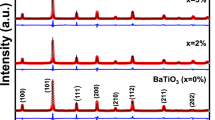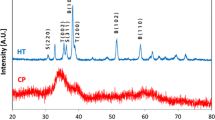A three-component ceramic material is obtained in the system ZrO2–SrTiO3–BiScO3; its phase composition and microstructure particularities are determined; and, the temperature dependence of the conductivity is studied. It is found that at room temperature the material consists of a cubic phase with space symmetry group Fm3m, corresponding to the cubic modification of zirconium dioxide, and a solid solution consisting of nonpolar cubic phase with Pm3m symmetry and polar tetragonal phase with P4mm symmetry characteristic for a two-component SrTiO3–BiScO3. An investigation of the microstructure and elemental composition of samples by means of scanning electron microscopy confirms the presence of these phases. It is found that above the temperature about 750 K the conductivity of the experimental samples increases significantly.




Similar content being viewed by others
References
D. F. Kalinovich, L. I. Kuznetsova, and É. T. Denisenko, “Zirconium dioxide: properties and applications (review of foreign literatiurs),” Poroshk. Metall., No. 11, 98 – 104 (1987).
J. Garsia-Barriocanal, A. Rivera-Calzada, M. Varela, et al., “Colossal ionic conductivity at interfaces of epitaxial ZrO2: Y2O3 /SrTiO3 heterostructures,” Chem. Phys. Chem., 10, 676 – 680 (2009).
T. Pennycook and M. P. Oxley, “Seeing oxygen disorder in YSZ/SrTiO3 colossal ionic conductor heterostructures using EELS,” Eur. Phys. J. Appl. Phys., 54, 3507 – 3511 (2011).
N. V. Zaitsev, E. P. Smirnova, and V. V. Lemanov, “Lattice symmetry and parameter of the solid solutions SrTiO3–PbTiO3,” Fiz. Tverd. Tela, 49, 488 – 489 (2007).
E. P. Smirnova, A. V. Sotnikov, N. V. Zaitseva, et al., “Relaxer behavior of the solid solutions SrTiO3–LiNbO3 ,” Fiz. Tverd. Tela, 50, 119 – 122 (2008).
V. V. Lemanov, E. P. Smirnova, A. V. Sotnikov, and M. Weihnacht, “Dielectric relaxation in SrTiO3–SrMg1/3Nb2/3O3 and SrTiO3–SrSc1/3Ta2/3O3 solid solutions,” Appl. Phys. Lett., 77, 4205 – 4207 (2000).
O. N. Ivanov, E. P. Dan’shina, V. V. Sirota, and I. D. Tarasova, “Formation of ceramic solid solutions in the system SrTiO3–BiScO3 ,” Izv. Ross. Akad. Nauk, Ser. Fizicheskaya, 74, 1312 – 1314 (2010).
O. Ivanov, E. Danshina, Y. Tuchina, and V. Sirota, “Ferroelectricity in SrTiO3–BiScO3 system,” Phys. Stat. Sol. (b), 248, 1006 – 1009 (2011).
O. N. Ivanov, E. P. Dan’shina, V. V. Sirota, and Yu. S. Tuchina, “Diffuse ferroelectric phase transition in a ceramic in the system SrTiO3–BiScO3 ,” Pis’ma Zh. Tekh. Fiz., 36, 85 – 92 (2010).
O. N. Ivanov, R. A. Lyubushkin, Ya. V. Trusova, and E. P. Dan’-shina, “Physical and technological factors determining the density of the composite nanostructure ceramic system Y–ZrO2–Al2O3 ,” Steklo Keram., No. 1, 15 – 19 (2012); O. N. Ivanov, R. A. Lyubushkin, Ya. V. Trusova, and E. P. Dan’shina, “Physical and technological factors determining the density of the composite nanostructure ceramic system Y–ZrO2–Al2O3 ,” Glass Ceram., 69(1 – 2), 16 – 19 (2012).
O. N. Ivanov, R. A. Lyubushkin, and V. V. Sirota, “Production and properties of zirconium ceramic from nanosize zirconium dioxide nanopowder,” Steklo Keram., No. 2, 25 – 28 (2011).
L. E. Cross, “Relaxor ferroelectrics,” Ferroelectrics, 151, 305 – 320 (1994).
V. G. Zavodinskii, “On the mechanism of ionic conduction in stabilized cubic zirconium dioxide,” Fiz. Tverd. Tela, 46(3), 441 – 445 (2004).
This work was supported by the RFFI and the government of Belgorod Oblast (contract No. NK 14-41-08032\15r_ofi_m) and the RF Ministry of Science and Education (contract No. 14.594.21.0010, unique code RFMEFI59414X0010; the hardware resources of the Center for the Collective Use of Scientific Apparatus ‘Diagnostics of the Structure and Properties of Nanomaterials’ were used within the framework of the research conducted under this contract).
One of us (O. N. Ivanov) also participated in the research as director for compliance with the measures ‘Organization of Scientific Research’ for the government task given to institutions of higher learning and scientific organizations in the sphere of scientific work (contract No. 2014/420-1).
Author information
Authors and Affiliations
Corresponding author
Additional information
Translated from Steklo i Keramika, No. 11, pp. 22 – 25, November, 2015.
Rights and permissions
About this article
Cite this article
Ivanov, O.N., Sudzhanskaya, I.V. & Yapryntsev, M.N. Manufacture, Structure, and Electric Conductivity of ZrO2–SrTiO3–BiScO3 Ceramics. Glass Ceram 72, 413–416 (2016). https://doi.org/10.1007/s10717-016-9800-4
Published:
Issue Date:
DOI: https://doi.org/10.1007/s10717-016-9800-4




